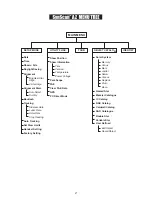
F
ocusing
C
alculating the magnification (power)
Fig.c
Slowly turn the focus knobs (Fig.c), one way or the other, until the
image in the eyepiece is sharp. The image usually has to be finely
refocused over time, due to small variations caused by
temperature changes, flexures, etc. This often happens with short
focal ratio telescopes, particularly when they haven't yet reached
outside temperature. Refocusing is almost always necessary
when you change an eyepiece or add or remove a Barlow lens.
5
U
sing the Red Dot Finder
The Red Dot Finder is a zero magnification pointing tool that uses
a coated glass window to superimpose the image of a small red
dot onto the night sky. The Red Dot Finder is equipped with a
variable brightness control, azimuth adjustment control, and
altitude adjustment control (Fig.a). The Red Dot Finder is
powered by a 3-volt lithium battery located underneath at the
front. To use the Finder, simply look through the sight tube and
move your telescope until the red dot merges with the object.
Make sure to keep both eyes open when sighting.
Azimuth
adjustment
control
ON/OFF
Brightness
Control
Altitude
Adjustment
Control
Battery cover
Sight Tube
Plastic
shipping
cover
Aligning the Red Dot Finder
Like all finderscopes, the Red Dot Finder must be properly
aligned with the main telescope before use. This is a simple
process using the azimuth and altitude control knobs.
Open the battery cover by pulling it down (you can gently pry at
the 2 small slots) and remove the plastic shipping cover over
the battery (Fig.b).
Turn on the Red Dot Finder by rotating the variable brightness
control clockwise until you hear a "click". Continue rotating the
control knob to increase the brightness level.
Insert a low power eyepiece into the telescope's focuser.
Locate a bright object and position the telescope so that the
object is in the centre of the field of view.
With both eyes open, look through the sight tube at the object.
If the red dot overlaps the object, your Red Dot Finder is
perfectly aligned. If not, turn its azimuth and altitude adjustment
controls until the red dot is merged with the object.
1.
2.
3.
4.
Fig.a
Fig.b
When you are looking at astronomical objects, you are looking through a column of air that reaches to the edge of
space and that column seldom stays still. Similarly, when viewing over land you are often looking through heat
waves radiating from the ground, house, buildings, etc. Your telescope may be able to give very high magnification
but what you end up magnifying is all the turbulence between the telescope and the subject. A good rule of thumb
is that the usable magnification of a telescope is about 2X per mm of aperture under good conditions.
magnification =
=
= 80X
Focal length of the telescope
Focal length of the eyepiece
800mm
10mm
The magnification produced by a telescope is determined by the focal length of the eyepiece that is used with it.
To determine a magnification for your telescope, divide its focal length by the focal length of the eyepieces you
are going to use. For example, a 10mm focal length eyepiece will give 80X magnification with an 800mm focal
length telescope.





































